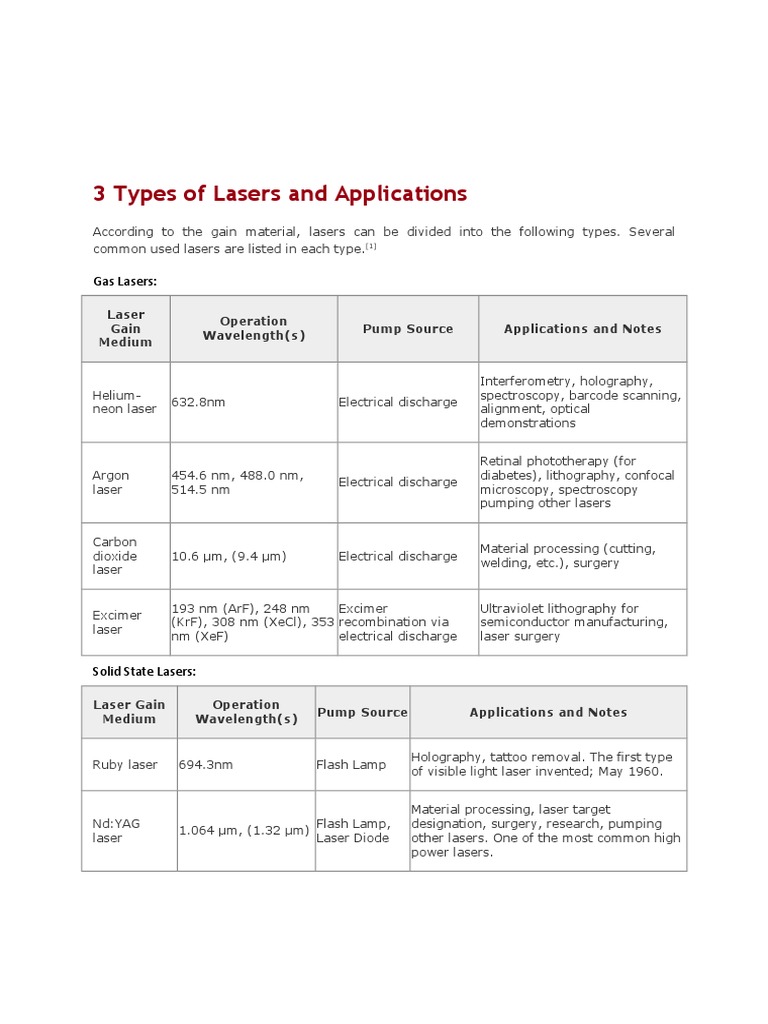Lasers, those enigmatic beams of concentrated light, have revolutionized myriad fields, extending their influence far beyond mere optical phenomena. Like focused rain that nourishes diverse landscapes, lasers have permeated various domains, illuminating the intricate tapestry of modern science and technology. From medical marvels to industrial powerhouses, the applications of lasers are not merely expansive; they are transformative. This article endeavors to explore the multifaceted uses of lasers, highlighting their unique appeal in various sectors.
1. Medical Applications: Healing Through Precision
Perhaps the most celebrated application of lasers resides within the realm of medicine. The medical field harnesses the power of lasers with precision akin to a surgeon’s scalpel. Laser surgery, a cornerstone of modern medical practice, employs focused beams to cut, coagulate, and vaporize tissue with unparalleled accuracy, alleviating the need for traditional surgical methods. In ophthalmology, procedures such as LASIK illustrate the transformative potential of lasers. By reshaping the cornea, this technique enables millions to regain their vision, often with minimal discomfort.
Moreover, lasers play a pivotal role in dermatology. From the removal of tattoos to the treatment of vascular lesions, the versatility of laser technology in skin care is profound. Fractional lasers rejuvenate skin by promoting collagen production, unveiling a fresher layer beneath the surface. The appeal lies not only in efficacy but also in the minimally invasive nature of these procedures, offering patients quicker recovery times and less scarring.
2. Industrial Utilization: The Cutting Edge of Production
The industrial landscape has seen a renaissance through the integration of laser technology. Laser cutting and engraving have revolutionized manufacturing processes, allowing for exquisite detail and precision in materials ranging from metals to plastics. Where traditional methods falter, lasers excel, offering clean cuts and reducing material waste. This efficiency signifies a leap toward sustainable practices in manufacturing, resonating with contemporary environmental ethos.
Welding, another domain transformed by lasers, illustrates the power of thermal energy in industrial applications. Laser welding provides strong joints with minimal thermal distortion, a feat often unattainable through conventional welding techniques. This mastery over energy not only enhances strength but also enables the construction of intricate assemblies, particularly in the aerospace and automotive industries. Here, the sky no longer presents a limit but an opportunity for innovation.
3. Communications Technology: The Invisible Thread
In the realm of communication, lasers serve as the backbone of fiber-optic technology. Just as threads weave an intricate tapestry, laser light transmits vast quantities of data over long distances with remarkable speed and fidelity. This transformative application is reminiscent of a digital highway, facilitating instantaneous communication across continents. The utilization of lasers in optical fiber networks exemplifies the intersection of physics and information technology, underscoring the elegance of modern infrastructure.
The intrinsic properties of lasers—coherence, directionality, and monochromaticity—allow for data transmission that is not only fast but also secure. As information traverse through fiber optics, signals experience minimal loss, rendering this technology a linchpin in the age of the internet and telecommunications. Thus, the invisible threads of laser technology bind societies closer together, transcending physical barriers.
4. Scientific Research: Illuminating Enigmas
Within the scientific community, lasers are revered tools utilized to probe the mysteries of the universe. Spectroscopy, a salient technique in chemical analysis, employs lasers to elucidate the composition of distant celestial bodies and terrestrial materials alike. With the precision of a jeweler examining a gem, scientists decipher the secrets of matter and energy, unveiling insights that propel our understanding of physics and chemistry.
Additionally, laser-based techniques such as laser-induced breakdown spectroscopy (LIBS) showcase the synergy of lasers and analytical chemistry. When a targeted material is ablated, the resulting plasma provides spectral information used to identify elemental composition. This capacity for high-resolution analysis positions lasers as indispensable assets in environmental monitoring, material science, and even forensic investigations, where they unravel clues embedded in evidence.
5. Consumer Products: A Touch of Laser in Everyday Life
Beyond the realms of high-tech industry and science, lasers have found their way into everyday consumer products, enhancing a multitude of experiences. Laser printers epitomize the marriage of technology and practicality, delivering sharp and vibrant print quality that was once the privilege of commercial printing. Similarly, barcode scanners, which utilize laser beams to interpret product information, have streamlined retail operations and improved inventory management.
The entertainment industry, too, owes a debt to laser technology. Laser light shows captivate audiences, transporting them into a realm where artistry meets precision. The mesmerizing patterns and colors, generated under the controle of laser beams, create an immersive experience that ignites the imagination. Here, lasers serve a dual purpose, both as instruments of science and as conduits for creativity.
Conclusion: The Beam of Possibility
The diverse applications of lasers illuminate their indispensable role across various sectors, akin to a lighthouse guiding ships through turbulent waters. From medical advances and industrial efficiencies to pioneering communication technologies and scientific exploration, lasers epitomize the interplay of light and innovation. As they continue to evolve, the future of laser applications beckons new possibilities, beckoning humanity to explore further into the realms of knowledge and creativity. Indeed, the journey of lasers is as illuminating as the light they emit, revealing the profound interplay between technology and the human experience.












